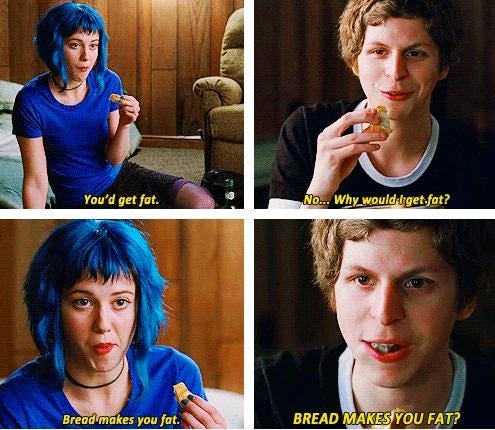"Bread Makes You Fat?!" A Short Essay on Language, Food Shame, and the Food Well-Being Model
How Our Attachment to Food Morality Impacts Our Food Choices
Let’s do a little exercise.
When I say the word food, what comes to mind? (take 10 seconds)
Was it a meal? Which meal? Hold the picture in your mind.
Now, what’s the first word you would think of to describe that food? (take 5 seconds.)
Now, I’m assuming some of those words could be tasty, yummy, good, etc.
Now, when you thought of this meal, what feeling did it bring up? Happiness? An old childhood memory? The grocery store?
Usually when we talk about a meal or food in general, it stirs up a feeling, regardless. Were any of those feelings surrounding whether you thought that food was “good” for you? or “bad” for you? Even healthy vs. unhealthy?
My question to you now is: why?
Where do we learn to have these feelings of “good” or “bad”, where did we learn to automatically categorize food into healthy vs. unhealthy? What creates that framework?
It’s quite interesting considering, food as a concept, has no moral value. A food cannot be good or bad. Even more so, what is “good” for one, may not be “good” for another. Food is so deeply subjective, Nutrition is deeply subjective.
To demonstrate, I will now give you an example with a childhood favorite: Scott Pilgrim vs. The World.
Scott Pilgrim and the “Fattening” Bread:
Several things are happening in this scene:
Scott Pilgrim (Michael Cera) expresses how joyful bread makes him
Ramona Flowers (Mary Elizabeth Winstead) sees this joy, and immediately cuts it short by saying “you’d get fat”, implying two things: 1) fat = bad 2) bread causes fat, which is bad in this context.
… now Scott Pilgrim is a romantic comedy that’s 15 years old this year (LOL), but this did some extensive damage to my young brain. This scene was meant to be a comedic one, and maybe in 2010 it landed more, but now all I can think of how Ramona fails to mention that bread is a great form of carbohydrates (necessary for brain functioning and energy levels), and fortified with iron, calcium, B vitamins, and folic acid.
(yes of course this is a movie, and this is more indicative of her character, but it’s still imprinted in my brain 15 years later!)
Language is powerful, when we allow these ideas to persist in culture, we create a dark cycle of food fear and resistance that leads us into misled and misinformed food choices.
The Morality of Food and the Shame That Goes With It
How often do we stop ourselves from eating something because of a fear that it will be “bad” or “fattening”? What do those words even really mean when it comes to food?
When do we get to actually enjoy food? When do we get to simply eat, without the looming fear of bad or good?
This is the trick of diet culture, this is the insurmountable pressure and expectation it thrusts onto all of us through society, pop culture, our communities. It keeps us separate from what food SHOULD be and that’s enjoyable, nutrient-dense, and energy-giving.
This is ALSO the trick of the wellness/diet culture influencer internet macrocosm. They make money off of your guilt. They make money off of your shame. This is the crux of the capitalistic billion dollar weight loss industry.
The more guilt and shame people feel around food, the more likely they are to buy a weight loss product or prescription.
This shame is not yours, it’s not mine, and we have to remember that the voice telling us what’s bad and what’s good often stems from an outdated ideology of framing food as good vs. evil.
What Informs Our Food Choice - A look to The Food Well-Being Model
Dr. Sonya Grier, a marketing professor at American University, developed the Food Well-Being Model as a way to further explain consumers relationship with food. Grief emphasizes in her work that shifting the idea of food being equivalent to health to food being equivalent to well-being was pivotal to understanding how food impacts not just immediate health outcomes, but emotional and psychological outcomes.
An excerpt from: Food Literacy: How Do Communications and Marketing Impact Consumer Knowledge, Skills, and Behavior? Workshop Summary
As opposed to a paternalistic view that entails telling people that a food is good or bad, Grier said, food well-being calls for thinking about people's goals and what they want to get from foods. Rather than restraint and restriction, for example—instead of saying, “Don't eat this” or “Don't eat too much of that”—food well-being takes a more positive approach. It involves thinking about how consumers view foods as pleasurable and as an important part of their lives, Grier explained. The focus is not on calories and weight but on how food is embedded in and contributes to people's lives.
She highlights five buckets: Food Availability, Food Policy, Food Socialization, Food Marketing, and Food Literacy. Each bucket contains several factors that can affect how we assign value to food and the food choice we make. To demonstrate these, let’s talk through a few examples.
Let’s start with food availability, if you were to live in a place that doesn’t have grocery store access, perhaps your focus is less on buying the best and “healthiest” food, but instead on the food that you think will do the least harm to your health. Or at least what you THINK is doing the least harm.
This leads me to food literacy, which describes the education surrounding food and nutrition, which is something that is not standardized across countries like the United States.
So if you are living in a place that does not have access to a grocery store, perhaps all you know to eat is fresh fruits and vegetables. This is great! But how do you get these foods in a corner store? Either frozen or canned foods.
The bigger issue here, is that many people when met with the choice to get frozen or canned fruits and vegetables, may prefer to simply not get them at all.
This could be due to food marketing, may be they have the thought that getting food that isn’t fresh isn’t worth their money? ONLY organic will do, and if they cannot afford that, they may as well get something cheap, tasty and filling.
Perhaps, their instagram feed has told them the only way to get fit is to eat red meat and sourdough. A facet of food socialization in many ways, which describes the culture around food practices, not only from family and friends, but at a societal level.
And yet, all of these problems could be resolved through food policy changes, which could see to programs around food education, city ordinances for more affordable grocery stores, stricter rules on nutritional misinformation, etc.

This framework gives us a new way to think about food choice and a chance to look at the bigger picture. Don’t seek to shame - rather seek to understand - to think of a world in which people can make a different choice than you, but that does not make you better or worse than them.
The TL;DR of this: There is no one thing that impacts food choice. There is no one thing that develops our opinions around food.
The morality we give to food stems from many facets of our lives, and the more we investigate the bigger picture, the more we may be able to identify when our own opinions impact our choices.





